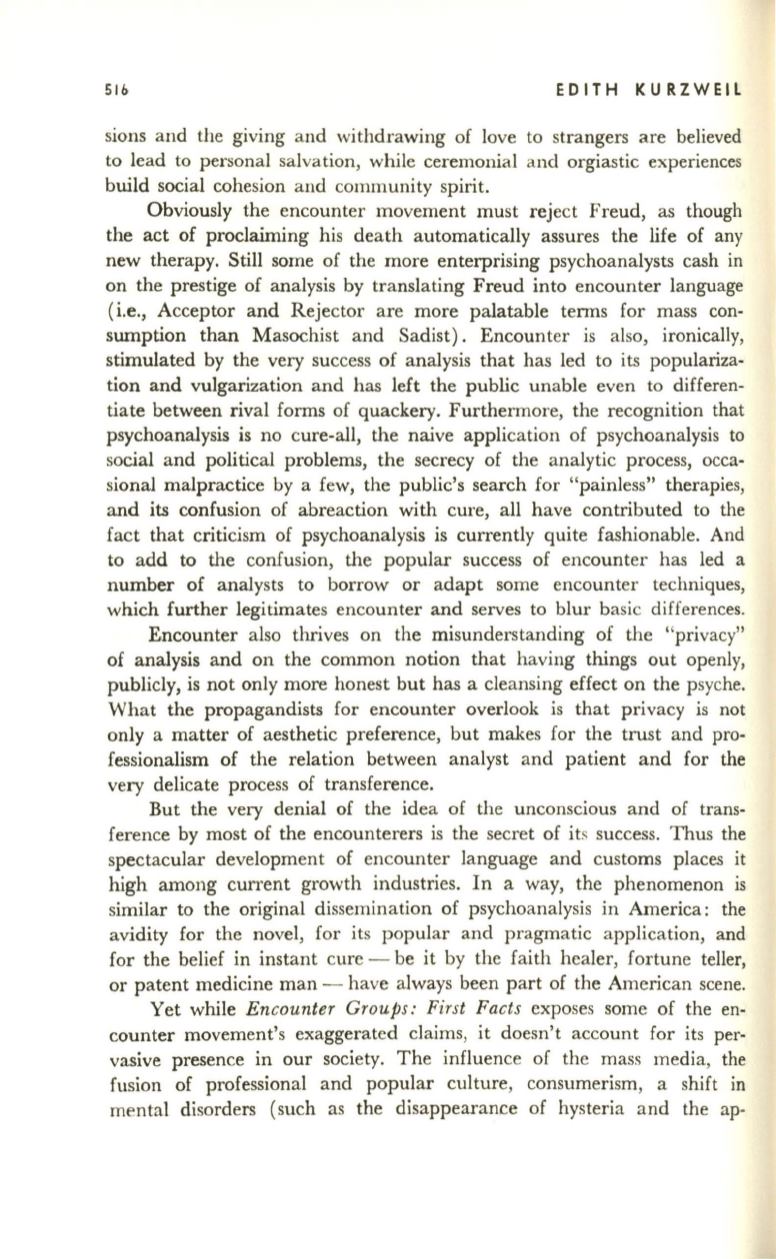
Sib
EDITH KURZWEll
sions and the giving and withdrawing of love to strangers are believed
to lead to personal salvation, while ceremonial and orgiastic experiences
build social cohesion and community spirit.
Obviously the encounter movement must reject Freud, as though
the act of proclaiming his death automatically assures the life of any
new therapy. Still some of the more enterprising psychoanalysts cash in
on the prestige of analysis by translating Freud into encounter language
(i.e., Acceptor and Rejector are more palatable terms for mass con–
sumption than Masochist and Sadist). Encounter is also, ironically,
stimulated by the very success of analysis that has led to its populariza–
tion and vulgarization and has left the public unable even to differen–
tiate between rival forms of quackery. Furthermore, the recognition that
psychoanalysis is no cure-all, the naive application of psychoanalysis to
social and political problems, the secrecy of the analytic process, occa–
sional malpractice by a few, the public's search for "painless" therapies,
and its confusion of abreaction with cure, all have contributed to the
fact that criticism of psychoanalysis is currently quite fashionable. And
to add to the confusion, the popular success of encounter has led a
number of analysts to borrow or adapt some encounter techniques,
which further legitimates encounter and serves to blur basic differences.
Encounter also thrives on the misunderstanding of the "privacy"
of analysis and on the common notion that having things out openly,
publicly, is not only more honest but has a cleansing effect on the psyche.
What the propagandists for encounter overlook is that privacy is not
only a matter of aesthetic preference, but makes for the trust and pro–
fessionalism of the relation between analyst and patient and for the
very delicate process of transference.
But the very denial of the idea of the unconscious and of trans–
ference by most of the encounterers is the secret of
it~
success. Thus the
spectacular development of encounter language and customs places it
high among current growth industries. In a way, the phenomenon is
similar to the original dissemination of psychoanalysis in America: the
avidity for the novel, for its popular and pragmatic application, and
for the belief in instant cure - be it by the faith healer, fortune teller,
or patent medicine man - have always been part of the American scene.
Yet while
Encounter Groups: First Facts
exposes some of the en–
counter movement's exaggerated claims, it doesn't account for its per–
vasive presence in our society. The influence of the mass media, the
fusion of professional and popular culture, consumerism, a shift in
mental disorders (such as the disappearance of hysteria and the ap-


